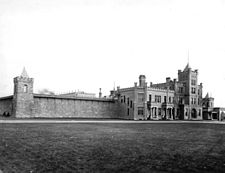Sugar House Prison (Utah)

The state penitentiary in 1903
|
|
| Coordinates | 40°43′23″N 111°50′56″W / 40.723°N 111.849°WCoordinates: 40°43′23″N 111°50′56″W / 40.723°N 111.849°W |
|---|---|
| Status | Defunct |
| Population | 575 (as of March 12, 1951) |
| Opened | January 1855 |
| Closed | March 12, 1951 |
| Managed by |
U.S. Marshals (1871-1896) Utah Board of Corrections (1896-1951) |
Sugar House Prison, previously the Utah Territorial Penitentiary, was a prison in the Sugar House neighborhood of Salt Lake City, Utah, United States. The 180-acre (73 ha) prison housed more than 400 inmates. It was closed in 1941 due to encroaching housing development, and all of its inmates were moved to the new Utah State Prison in Draper. The site is now occupied by Sugar House Park and Highland High School.
In January 1852 Territorial Assembly of the Utah Territory approved a memorial requesting Congress appropriate $70,000 for a territorial penitentiary. Congress approved an appropriation of $20,000 in March 1853 and plans were drawn up. The following October, territorial governor Brigham Young selected the 10-acre (4.0 ha) government-owned site, then known as "The Big Field Survey", about six miles from central Salt Lake City. Sixteen "cozy cells dug into the ground, with iron bars on top" comprised the original prison at a cost of $32,000. The facility that became known as the Utah Territorial Penitentiary was opened in 1855. In 1867, the Utah Territorial Legislature determined that the prison was inadequate and once considered moving it onto an island in the Great Salt Lake. From 1871 to 1896, the penitentiary was federally operated by U.S. Marshals. The inmate capacity was expanded in 1875 to accommodate 300 individuals with the construction of a new cell house and prison walls.
In 1896, the buildings and surrounding lands were given to the newly created State of Utah and were designated as the Utah State Prison, sometimes referred to as the "state pen". Starting in 1900, executions by the state were carried out in the prison. Prior to that, death penalties were administered in the counties where the crimes had been committed. Tickets were distributed in 1903 for admission to publicly view an execution by firing squad.
...
Wikipedia
